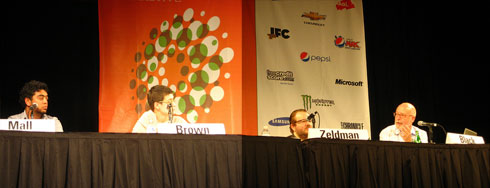
AFTER ALL THESE YEARS designing websites and applications, I still don’t think in words like “affordance.” And when my colleagues use a word like that, my mental process still clatters to a halt while I seek its meaning in a dusty corner of my brain. (When someone says “affordance,” there’s always a blank where thought stops, and then I see a mental image of a finger pushing a button or stroking a surface. Somehow that one image stands in for everything I know about what “affordance” means, and I’m able to jump back into the discussion and catch up with everyone else.)
Should you ask B.B. King if the lick he just played was in Lydian Mode, he could probably answer you after stopping to think about it. But after all these years playing blues guitar, B.B. King doesn’t say to himself, “I’m going to switch to a Lydian scale here,” he just plays blues. Scales and vocabulary are necessary when we are learning the craft behind our art. But the longer we practice, the more intuitive our work becomes. And as it becomes more intuitive, it disconnects further and further from language and constructs.
This is why young practitioners often argue passionately about theory while older practitioners tell stories and draw pictures.
Of course any practitioner, green or experienced, can create a word to describe the work we are inventing together, just as anyone, young or old, can have the next great idea. And it is most often the young who come up with exciting new ideas in UX and design and on the internet—possibly because they are still exploring theories and trying on identities, while those who work more intuitively may shut themselves off from the noise of new ideas, the better to perfect a long-term vision.
But the nice thing about the experience arc I’m proposing is that it allows younger practitioners to use words like “affordance” when working together to create a website or application (and soon we will stop distinguishing between those two things), while the older, storyteller practitioners use simpler, down-to-earth language to sell the work to clients, investors, or users.
We need both kinds of practitioners—theorists and those for whom everything has become intuitive second nature—just as we need both kinds of communication (craft vocabulary and storytelling) to do Our Jobs in Cyberspace.™ Don’t you think?
Where are you on this arc? Are you the kind of designer who gets fired up from reading a new theory? Or do you sketch and stumble in the dark, guided only by some Tinker Bell twinge in the belly that tells you no, no, no, no, hmm, maybe?







